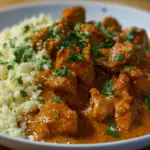How Pork Rinds Are Made! If you’ve ever taken a moment during a ballgame, a party, or just a night at home to really listen, you might have heard it – the unmistakable symphony of a thousand crunches echoing around the room.
That’s right, we’re talking about the guilty pleasure and comfort food extraordinaire, pork rinds! And while we’ve all relished the crackle of these delights, how often have we paused to ponder their origin? Do you know the journey these delectable morsels take from the farm to your bowl? Let’s dive in, shall we? This is a story full of heat, transformation, and a tasty end.

A Swine Story
Pork rinds, also known as chicharrones in Spanish, start off as a humble cut of pork skin. Once the pig is processed for its meat, the skin is carefully removed, retaining a small layer of fat. This is then sliced into bite-sized pieces – the very pieces that eventually transform into the crunchy pork rinds you know and love.
How Pork Rinds Are Made: Preparation is Key
Before the skin can be fried into rinds, it undergoes a preparation process. This generally involves boiling or roasting to render some of the fat and soften the skin. It is then thoroughly chilled, which makes it easier to cut into those recognizable rectangular pieces.
- Pork skin is cleaned and boiled to remove any remaining hair or impurities
- The skin is then cut into small pieces and dried
- The dried skin is fried in hot oil until it puffs up and becomes crispy
- Seasonings or flavors can be added after frying
- The final product is packaged and sold as pork rinds or chicharrones.
Also Read: Cheap Keto Fast Food Options: Keep It Low-Carb On-The-Go
The Magic of Popping

The next step is the most important (and fascinating) of all: the popping. This is where those little bits of pork skin transform into the crunchy, airy snacks we adore. The prepared skin pieces are deep-fried in lard or vegetable oil at a high temperature. As they fry, the moisture in the skin quickly turns into steam, causing the skin to expand and “pop” much like popcorn. It’s a mesmerizing spectacle of food metamorphosis!
Flavor Finesse
Up until now, our pork rinds are technically ready to eat, but they’re still a far cry from the zesty, mouth-watering treats we’re used to. That’s where seasoning comes in. Fresh out of the fryer, the hot pork rinds are quickly dusted with a blend of spices. Traditional flavors include salty, spicy, and smoky, but the sky’s the limit with flavors ranging from tangy barbeque to zesty chili and lime.
Packaging and Distribution
Finally, the rinds are ready to be packed. They’re weighed and packaged, ready to be shipped off to grocery stores near and far. And when you crack open a bag, you’re enjoying the end result of a process steeped in culinary tradition and a whole lot of flavor.
| Step | Description |
|---|---|
| 1. Source the Skin | Pork rinds start off as pig skin. The skin is carefully removed during the meat processing stage. |
| 2. Preparation | The skin is then boiled or roasted to render some of the fat and soften the skin, making it easier to work with. |
| 3. Chilling and Cutting | After boiling or roasting, the skin is typically chilled to facilitate cutting. It’s then sliced into small, bite-sized pieces, ready for frying. |
| 4. Deep-Frying | The cut pieces are deep-fried at high temperatures in oil (often lard). As they fry, the moisture in the skin turns to steam, causing the skin to expand and ‘pop’, creating the characteristic puffed texture. |
| 5. Seasoning | Fresh from the fryer, the hot pork rinds are quickly seasoned with a variety of spices. Traditional flavor profiles include salt, pepper, and sometimes smoky or spicy seasonings. |
| 6. Packaging | Once cooled and seasoned, the pork rinds are ready to be packaged and distributed to stores for consumers to enjoy. |
A Snack for Modern Times

Interestingly, pork rinds have seen a surge in popularity recently, and not just for their satisfying crunch. They’re high in protein, low in carbs, and fit neatly into popular eating plans like the ketogenic diet. Whether they’re used as a substitute for chips, breadcrumbs, or simply enjoyed on their own, pork rinds are proving that they’re much more than a simple snack.
You Can Check This Awesome Video From Food Network
Crafting the Perfect Pork Rinds
The journey of pork rinds from farm to your plate is a tale of transformation. From simple pig skin to a popping spectacle and finally a flavorful crunch, every step adds something special to the final product. The next time you reach for a handful of pork rinds, take a moment to appreciate the culinary journey they’ve made to reach you. Enjoy the crunch – you’re part of the story too!
Are pork rinds deep-fried?
Yes, pork rinds are deep-fried. The process of deep-frying causes the moisture in the skin to turn into steam, which makes the skin puff up and become crispy.
What are pork rinds made from?
Pork rinds are made from pig skin. The skin is sliced into appropriate sizes and then processed to create the finished product.
What kind of oil is used to fry pork rinds?
Pork rinds are often fried in lard, which is pig fat. However, they can also be fried in other types of oil, such as vegetable oil.
Can you make pork rinds at home?
Yes, you can make pork rinds at home, although it can be a time-consuming process. You would need to obtain pork skin, render some of the fat, cut it into pieces, and then deep-fry the pieces until they puff up. Homemade pork rinds can be seasoned to taste.
Are pork rinds healthy?
Pork rinds are high in protein and have zero carbohydrates, which makes them a popular snack for people following a ketogenic or low-carb diet. However, they are also high in saturated fat and sodium, so they should be eaten in moderation.
Are pork rinds healthier than regular chips?
It might come as a surprise to learn that pork rinds are a healthier alternative to potato chips in terms of nutrition. Due to their low carbohydrate content, they won’t cause a spike in blood sugar and will instead help you eat fewer calories overall, which will result in long-term weight loss.
Are pork rinds the same as cracklings?
While both pork rinds and cracklings are made from pig skin, they’re not the same. Pork rinds are puffy and light, while cracklings include a layer of fat beneath the skin, making them denser and richer in flavor.





Leave a Reply